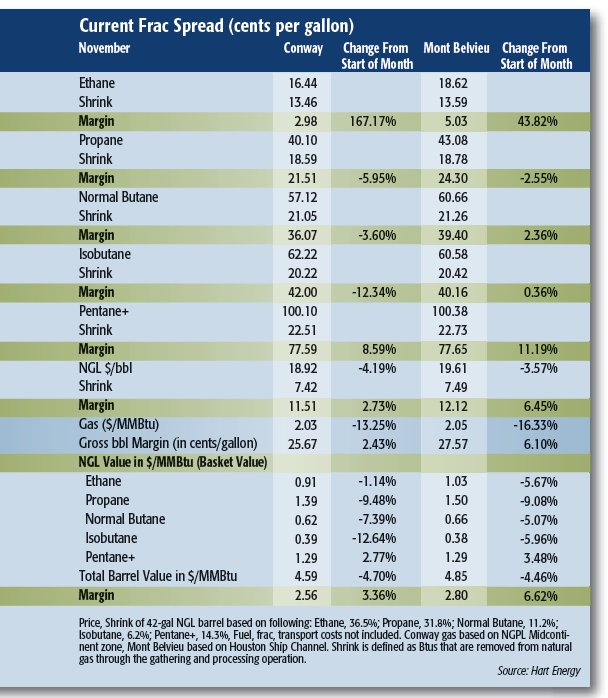It’s been a slow climb out of the negative zone for ethane, but for the first time in more than two years, margins for the product were positive at both the Mont Belvieu, Texas, and Conway, Kan., NGL hubs for an entire month in October. Though these margins have been thin, the fact they have not only remained steady but continued to grow is a testament to the effectiveness that widespread rejection has had on the industry.
Positive margins continued into November, but there was a potential headwind for the product with reports that ethane stocks grew in August, the most recent month for which data are available from the U.S. Energy Information Administration.
This was a surprise given that there had been a decrease in storage levels the previous month and ethane crackers were running at 95% of total capacity. It has been speculated that this build could have come from ethane being sold from petrochemical companies’ private inventories. However, the volumes that would be necessary for such a large build would have disrupted prices and ethane has held firm for several months.
The good news is that unless ethane stocks build consistently for several months, it is likely that prices will begin to improve, along with margins as more ethane cracking capacity is brought online in 2016.
While it is tempting to say that the worst is behind the industry for the ethane market, that is unlikely to be the case. Prices will probably not fall to their lows of the past few years, but rejection into the gas stream will continue throughout much of the country aside from cracking regions.
The ethane market is past the worst part of the storm, but it will not be out from under the clouds for at least another 12 to 18 months.
Propane markets experienced some positives of their own as November began and European and Asian price increases supported U.S. exports, but this was the eye of the storm and the markets will be heading back into bad weather soon. Late November forecasts predicted near-record cold in the Midwest.
The market is still battling the major headwind—record storage levels. Even as LPG exports increase with new capacity coming online, overhangs will not be worked off this winter.
This will put the propane market in much the same boat as natural gas once spring arrives, as the market will be severely oversupplied.
Recommended Reading
EQT Sees Clear Path to $5B in Potential Divestments
2024-04-24 - EQT Corp. executives said that an April deal with Equinor has been a catalyst for talks with potential buyers as the company looks to shed debt for its Equitrans Midstream acquisition.
Hess: Pre-emption Provision Doesn't Apply to Buyout Deal With Chevron
2024-02-27 - Hess Corp. said on Feb. 27 that a pre-emption provision does not apply to its proposed $53-billion buyout by Chevron Corp. and it remains "fully committed" to the deal.
EQT, Equitrans Midstream to Combine in $5.5B Deal: Reports
2024-03-11 - EQT Corp.'s deal would reunite the natural gas E&P with Equitrans Midstream after the two companies separated in 2018.
Ithaca Energy to Buy Eni's UK Assets in $938MM North Sea Deal
2024-04-23 - Eni, one of Italy's biggest energy companies, will transfer its U.K. business in exchange for 38.5% of Ithaca's share capital, while the existing Ithaca Energy shareholders will own the remaining 61.5% of the combined group.
ONEOK CEO: ‘Huge Competitive Advantage’ to Upping Permian NGL Capacity
2024-03-27 - ONEOK is getting deeper into refined products and adding new crude pipelines through an $18.8 billion acquisition of Magellan Midstream. But the Tulsa company aims to capitalize on NGL output growth with expansion projects in the Permian and Rockies.


